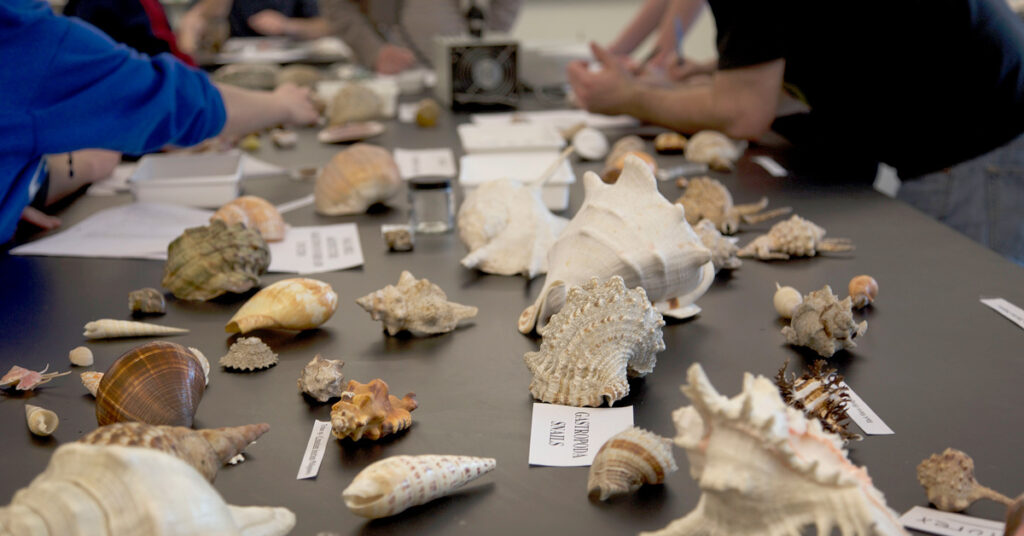See shells

Some day soon, scholars around the world will be able to view thousands of shell specimens from a Wheaton College biology collection—and even produce plastic replicas using a 3-D printer.
It’s part of an ongoing effort among colleges and universities to digitize material collections and make them available to a larger audience, and it’s a cause supported locally by Digital Initiatives Librarian Amy Bocko, who recently secured a grant from the Council of Independent Colleges toward that effort.
“One of the new focuses of libraries and where library services are going in the 21st century is creating open educational resources that students can use here on campus to make for a richer learning experience and that we can share in the wider community,” she said.
Bocko first came across Wheaton’s shell collection—more than 3,500 specimens dating as far back as the late 1800s and currently managed by Professor of Biology Scott Shumway—about a year and a half ago, when she was asked to photograph a portion of the collection to highlight on the college website. When the CIC grant opportunity came up more recently, Bocko immediately thought of the shells.
“The grant was aimed at finding hidden collections on campus, digitizing and preserving them, and bringing them to life,” she said. “One of my interests is creating content for the sciences, so I contacted Scott and offered my reasons for why it was a great idea.”
Shumway uses the shells in his marine biology lab to illustrate the diversity of the mollusc phylum. But the collection’s origin is a mystery to him.
“When I first taught marine biology in the spring of 1992, I found many shells stored away in the drawers of the ecology lab. They were dusty, and many had not seen the light of day in years, if not decades,” he said.
About 20 years later, as he was packing up the lab to move to the new Mars Center for Science and Technology, he came across more boxes of shells.
“I opened one dusty box that had shells wrapped in newspapers dating from 1967. The boxes were labeled ‘send to new science center.’ This would have been the move from the ‘old’ science center in Knapton to the ‘new’ science center, now commonly referred to as the ‘old’ Science Center,” he said. “Some of the snail shells have tiny paper labels tucked into their openings that are so old and fragile they crumble when unfurled. These were most likely collected in the late 1800s to early 1900s.”
Looking further into the collection’s history, Shumway learned that Professor of Biology John Kricher had moved part of the collection into the lab after discovering them in the early 1970s in a storage space. Kricher didn’t add to the collection, but it is believed that former professor Clinton MacCoy, who specialized in aquatic and marine systems, may have contributed to it. Shumway, too, has added to the collection: common shells of New England and New Jersey.
As a recipient of the CIC grant, made possible with financial support from the Andrew W. Mellon Foundation, Wheaton is now a member of the new Consortium on Digital Resources for Teaching and Research, along with 41 other liberal arts colleges and universities across the country. Consortium members receive a subscription to Shared Shelf, a feature of the digital resource database Artstor that enables institutions to upload, catalog and share their collections (Wheaton already has a membership but will be able to expand it through the CIC grant). The grant also will enable Wheaton staff to attend a series of workshops.
Bocko hopes to hire a student intern to digitize the shell collection. She also plans to work with students and faculty in the WHALE lab to 3D scan some of the more unique specimens and share the source code with other institutions so they can print out their own versions of the shells to study.
The shell project is just one example of the kind of work being done by Wheaton’s new Digital Initiatives Department, part of Library and Information Services. Other recent projects include digitizing account books from Wheaton’s days as a female seminary and a collection of student research journals from Professor of Biology Bob Morris’ classes.
Finding and sharing Wheaton’s hidden treasures is a big part of what Bocko loves about her job.
“You take these unique materials that the only way you’re ever going to see them is if you make an appointment and you come to Archives and you sit there and look at them, and now with all the different technology we have we’re able to breathe this new life into them digitally and offer people anywhere the same experience to view things,” she said. “It’s an exciting, challenging field to be in.”
